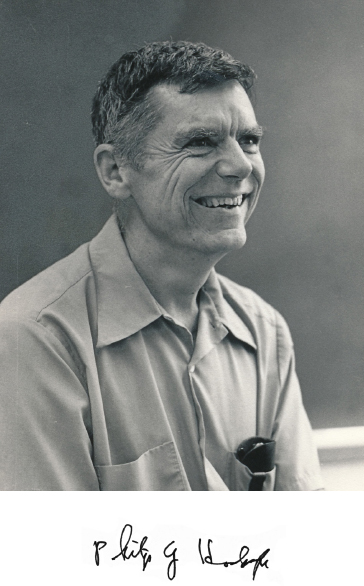1920–2014
Elected in 1977
“Leadership in the development of methods for the analysis and design of structures stressed beyond the yield point.”
BY ROBERT PLUNKETT
PHILIP GIBSON HODGE, professor emeritus of mechanics at the University of Minnesota, died of natural causes on November 11, 2014, in Sunnyvale, California.
Philip was born in New Haven, Connecticut, on November 9, 1920, to Philip Gibson Hodge, a New York publisher and Foreign Service officer, and Muriel Miller Hodge. He received a BA in mathematics from Antioch College in 1943. Immediately after getting his degree he married Thea E. Drell and joined the Merchant Marine, where he began by teaching basic math to radio operators, then shipped out as a mariner for the duration of World War II. After discharge he enrolled in the graduate program in applied mathematics at Brown University, where he studied under the guidance of William Prager. As part of his studies, he and Dr. Prager developed the basic foundation for the rigorous analysis of perfectly plastic solids. Together they wrote Theory of Perfectly Plastic Solids, the first of Philip’s five books. Theory was published in 1951, and to this day it remains the ultimate authority in its field.
After receiving his PhD in 1949 he taught mathematics at the University of California, Los Angeles, as an assistant professor. His most engaging memory at that time was that he converted a member of the football team from a physical education major to one in mathematics! He was next appointed
associate professor of applied mechanics at Brooklyn Polytechnic Institute in 1953, then professor of mechanics at the Illinois Institute of Technology in 1957, where he led a vigorous graduate school program in the theoretical aspects of solid mechanics. His final position was as professor of mechanics at the University of Minnesota, as of 1971. There he joined three other NAE members in a rather small department. They and the other members of the department faculty conducted a strong program in solid mechanics, fluid mechanics, and analytical dynamics. During his tenure, he was known as a very effective and well-liked teacher at both the undergraduate and graduate levels. From his retirement in 1991 to his death, he was professor emeritus of the University of Minnesota and visiting professor emeritus at Stanford University.
Philip wrote over 100 papers published in peer-reviewed journals. His extensive research on continuum mechanics methods applied to plastic materials resulted in five well-known books: the one previously mentioned, coauthored with Dr. Prager; another coauthored with J.N. Goodier, a well-known researcher in the theory of elasticity; and three others of his own that covered various aspects of continuum mechanics.
Both his education and early research in applied mathematics revolved mainly around the secure foundation of mathematical analysis and partial differential equations. However, earlier than many, he realized that the advent of fast digital computers had changed the field drastically. As early as the 1970s many of his papers included work on both the formulation and solution of finite element analysis problems in the field. He also found these techniques to be particularly useful for the vexing engineering problems of design by limit analysis. Limit analysis is a multiparameter exploration technique. It is dedicated to the development of efficient methods to directly determine estimates of the collapse load of a given structural model, without resorting to iterative or incremental analysis. It is based on a set of theorems, limit theorems, which in turn are based on the laws of conservation of energy and other laws descriptive of material behavior. It is widely used for the design of large civil engineering structures, such
as buildings and bridges. His contributions here were recognized by the American Society of Civil Engineers (ASCE) with its award of the Theodore von Karman Medal in 1985.
During his career in research and education, in addition to his five books, his published papers, and over 30 graduate students, he made many contributions to the leadership of professional societies. He was technical editor of the American Society of Mechanical Engineers (ASME) Journal of Applied Mechanics for five years and served on many ASME committees, including five years on the executive committee of the Applied Mechanics Division, several years on the ASME Nominating Committee (including as its chair), and several years on the Honors Committee, in addition to several other societywide committees. His greatest contribution to our profession may have been his 18 years as secretary of the US National Committee on Theoretical and Applied Mechanics—he served in that position longer than any other secretary. During that time he was also a delegate to the International Union for Theoretical and Applied Mechanics General Assembly and later a member-at-large.
His contributions were recognized by many awards and honors, including the ASME Medal (1987) and honorary membership (1977), as well as awards from ASCE and the Russian Academy of Science.
In addition to his many contributions to engineering, Philip was an avid outdoorsman. He was a hiker, camper, backpacker, cross-country skier, and marathoner until long after his retirement. He was proud of his two Boston Marathons and of having finished first in the Senior Section of the Twin Cities Marathon. He slowed down a little only when his knees began to bother him in his late sixties and his doctor warned him, “You can run now or walk later!” He was an opera aficionado and wrote published opera reviews until fairly recently. His wife Thea had been a senior software executive for Cray Computers while they lived in Minneapolis. She preceded him in death by several years. He leaves three children: Susan E. Hodge, Philip T. Hodge, and Elizabeth Hodge Kelly, and many grandchildren and great-grandchildren.





